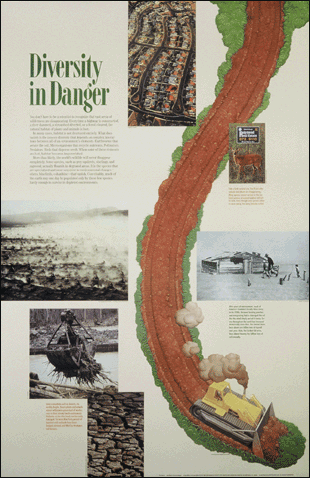 |

|


You don't have to be a scientist to recognize that
vast areas of wilderness are disappearing. Every time a highway is constructed,
a river dammed, a streambed diverted, or a forest cleared, the natural
habitat of plants and animals is lost.
In many cases, habitat is not destroyed entirely. What does vanish is
the unseen diversity that depends on complex interactions between all
of an environment's elements. Earthworms that aerate the soil. Microorganisms
that recycle nutrients. Pollinators. Predators. Birds that disperse seeds.
When some of these elements are lost, habitat becomes impoverished.
More than likely, the world's wildlife will never disappear completely.
Some species, such as grey squirrels, starlings, and ragweed, actually
flourish in degraded areas. It is the species that are specialized and
more sensitive to environmental changes-otters, bluebirds, columbine-that
vanish. Conceivably, much of the earth may one day be populated only by
those few species hardy enough to survive in depleted environments.
|
| |

Beacham’s Guide to the Endangered Species of
North America
*R-SIBL QH77 .N56 .B43
Encyclopedia of Endangered Species
*R-SIBL QH75.A1 E53
IUCN Red List of Threatened Animals
*R-SIBL QL82 .T43

Computer Indexes
General Science Abstracts
Biology Digest
Print Indexes
General Science Index*R-SIBL
Z7401 .G46
Biological Abstracts*R-SIBL QH301 .B37
|

Our Vanishing Relative: the status of wild oran-utans
at the close of the twentieth century
by H. D. Rijken
JSE 00-136
Killing Game: international law and the African elephant
by D. J. Harland
JBE 94-2481
Prescription for Extinction: endangered species and
patented oriental medicines in trade
by Andrea L. Gaski
JSF 95-848

|